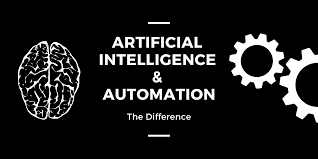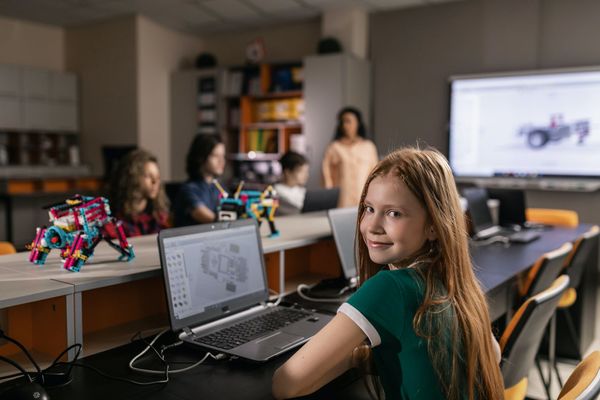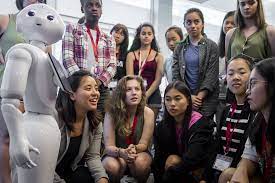Automation Vs. Artificial Intelligence
These terms are highly trending in the current world. However, there are often misconceptions about the both. For one, Artificial Intelligence is more than automation. This article has been prepared by subject matter experts to give a comprehensive view into each section. That is, the concepts of Automation as well as AI will be explained clearly along with their differences. The objective of SchoolforAI is to impart the most complex knowledge in a simple and direct fashion. Here we go.
Automation
The definition of automation is evident in its name. It is the use of technology or other tools to automate tasks; that is complete jobs with minimum or no human intervention. Let us consider some real-life examples. You wake up late because you feel comfortable in bed? What if your fan/air conditioner could automatically get switched off at 6:00 am in the morning? Won’t that force you to wake up? That’s the simplest form of automation.
Now let us get a little more professional. What about automation in workplaces and/or industries? What if machines (especially those used in manufacturing units) could process themselves automatically? For example, have you seen or heard about a factory that manufactures cool drinks? Different machines are made to pick raw material, mold bottles from glass or plastic, cool them, and then fill drinks. Human intervention or rather human instructions are needed at every stage. A person switches on the machine makes it pick raw material and controls the entire process until the final creation of the cool-drink. Automation enables a machine to do all this for thousands of bottles in the shortest time and with accuracy.
Automation is also applicable to various industries including IT where automation is widely used in software testing, service support, data backup & restoration and so on. Hence, we could say that automation is not only those physical moving Robot arms but also software that silently completes the task.
Artificial Intelligence
The simplest definition of AI is that machines are made to imitate human actions with a few sets of instructions. Think of the concept like this. What if you could teach a system or machine to give a correct response when someone asks, “What is the time?” Or, or get a machine to hand you a cup of water when you say you are feeling thirsty? That’s AI for you! Some applications of AI are:
- Expert Systems- An expert system is a computer program that is designed to solve complex problems. It also has decision making abilities like a human expert. That is, a computer program can understand logic. For example, a patient who is 37 years old, 5 ft 8 inches height and 75 kgs weight wishes to know how to stay fit. An expert system can immediately diagnose the patient and refer to tons of records on the patient’s health history to give an apt solution. There will be no need to supervise the patient’s health for a long time and/or check several files for the same. Everything can be completed in seconds with the help of expert systems.
- Natural Language Processing – Natural Language Processing (NLP) is a branch of Artificial Intelligence (AI) that enables machines to understand the human language. To understand, we must consider normal human languages such as English, Tamil, Telugu, Hindi, and more. There will be several dialects and each person may sound different when he/she utters a word. Natural Language processing helps a machine to make sense of these words automatically perform tasks that include translation, spell check, or topic classification.
- Speech Recognition- Speech recognition, also known as automatic speech recognition (ASR), is the capability to process human speech into a written format. That is, a machine can create written texts from whatever you speak. This type of AI can be very useful in documenting speeches during campaigns and also for recording conversations to conduct inquiries later. For example, everything spoken between two people in a crime scene can be documented and analyzed for evidence using speech recognition.
- Machine Vision- Machine Vision enables systems to identify objects, analyze scenes as well as activities in real-life visual environments. In other words, a system can identify people, places, shapes or anything that is not ordinary. A computer is fed with lots of visuals and images of every recognized person, object and/or shape in a building. For anything the attached camera notices is different from what was recorded, it raises alarms. This concept can be very useful for CCTV cameras and to notify people about unauthorized entry, to analyze medical images, monitor buildings and inspect construction areas.
We have secured conceptual understanding about AI and Automation. However, there has always been confusion between Automation and AI which we intend to clear through highlighting their differences in a tabular form.
AI VS AUTOMATION
Find these pieces of information interesting? More info as well as guidelines to make best use of this information can be gained with us. SchoolforAI is a hybrid training platform where the courses have been prepared by several industry experts. We cover all aspects of the subject in an interesting and interactive manner. Upgrade your skills and become better the rest of the world using our democratized classes. With SchoolforAI, Artificial Intelligence will no longer be limited to advanced professionals in the world. It will simply become a way of life. Give us, mail us or visit our office to know more.
************




